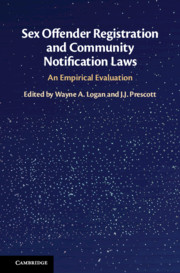Book contents
- Sex Offender Registration and Community Notification Laws: An Empirical Evaluation
- Sex Offender Registration and Community Notification Laws
- Copyright page
- Contents
- Contributors
- Preface
- Acknowledgments
- 1 Origins and Evolution
- 2 Variations in the Structure and Operation of SORN Systems
- 3 Registries and Registrants:
- 4 Law Enforcement and SORN
- 5 The Public and SORN Laws
- 6 The Ancillary Consequences of SORN
- 7 Offenders and SORN Laws
- 8 Integrating the Etiology of Sexual Offending into Evidence-Based Policy and Practices
- 9 Juvenile Registration and Notification Are Failed Policies That Must End
- Conclusion
- Index
- References
7 - Offenders and SORN Laws
Published online by Cambridge University Press: 11 June 2021
- Sex Offender Registration and Community Notification Laws: An Empirical Evaluation
- Sex Offender Registration and Community Notification Laws
- Copyright page
- Contents
- Contributors
- Preface
- Acknowledgments
- 1 Origins and Evolution
- 2 Variations in the Structure and Operation of SORN Systems
- 3 Registries and Registrants:
- 4 Law Enforcement and SORN
- 5 The Public and SORN Laws
- 6 The Ancillary Consequences of SORN
- 7 Offenders and SORN Laws
- 8 Integrating the Etiology of Sexual Offending into Evidence-Based Policy and Practices
- 9 Juvenile Registration and Notification Are Failed Policies That Must End
- Conclusion
- Index
- References
Summary
Chapter 7 describes what we know about the effects of SORN laws on criminal behavior. A coherent story emerges from this review: there is virtually no evidence that SORN laws reduce recidivism or otherwise increase public safety. The chapter first delineates the various ways registration and notification alter the legal environment not only for registrants but also for nonregistrants, the public, and law enforcement. There are many channels through which SORN laws might impact the frequency of sex offenses, including some that would produce an increase in overall offending. The chapter assesses these possibilities in light of a large body of relevant empirical research, focusing on potential changes in registrant recidivism, nonregistrant criminal behavior, the geography of victimization, and the distribution of types of sex offenses and victims. Scholars have plumbed many different data sources using a range of methodologies, yet nearly every study finds no evidence that SORN laws – in particular, community notification laws – reduce sexual recidivism. In fact, notification laws may increase recidivism risk. The final section discusses registrant beliefs about the effects of SORN laws. In sum, the chapter comprehensively engages with the pressing question of whether SORN laws protect the public and concludes that they do not.
Keywords
- Type
- Chapter
- Information
- Sex Offender Registration and Community Notification LawsAn Empirical Evaluation, pp. 102 - 144Publisher: Cambridge University PressPrint publication year: 2021



